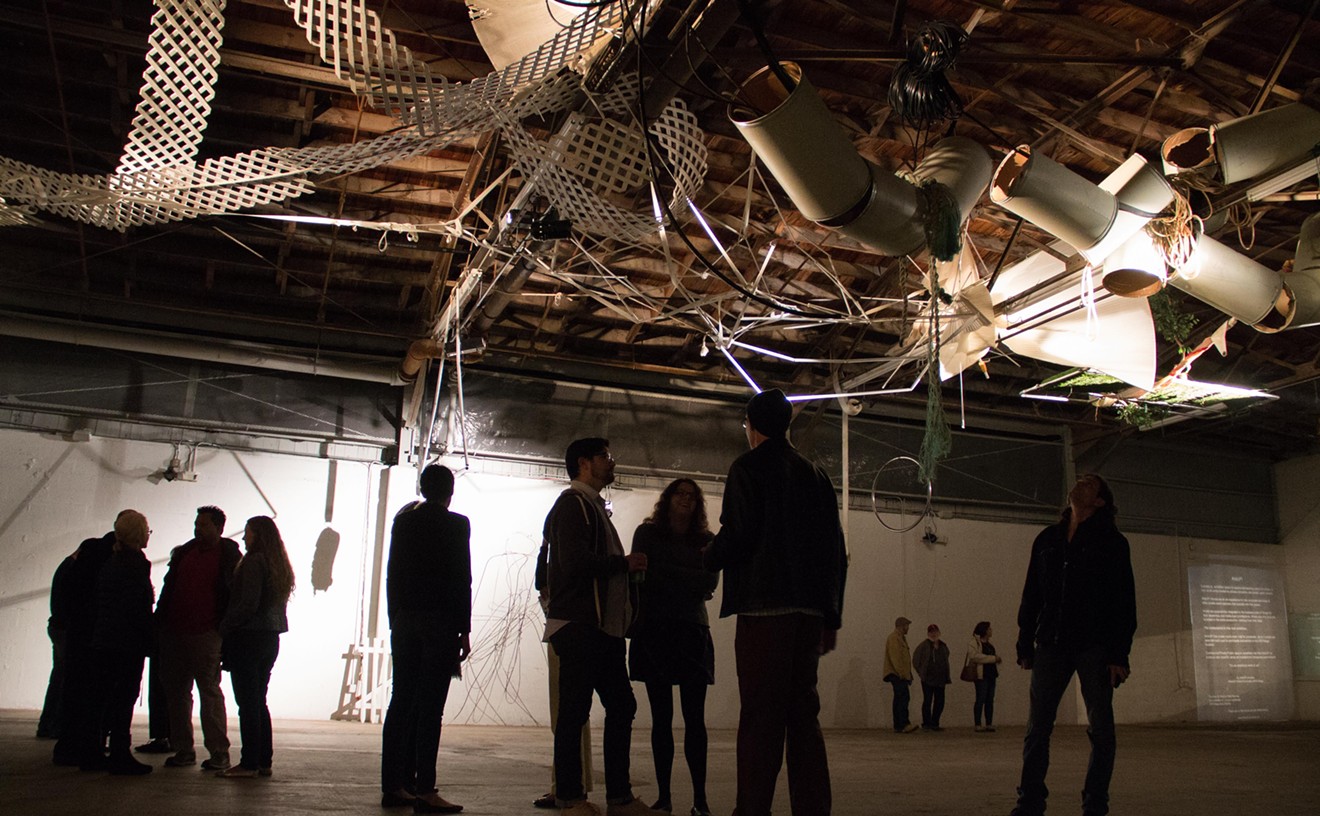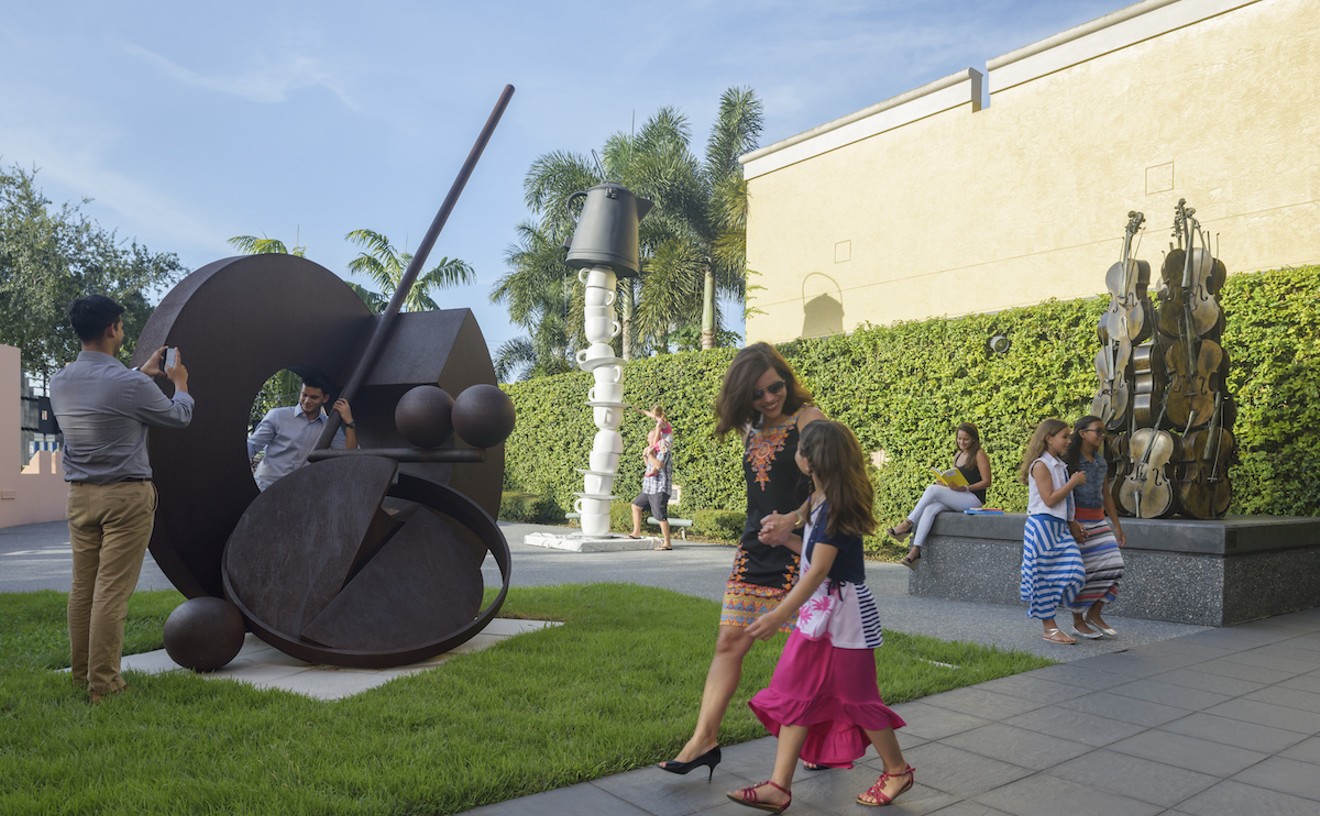When she's not acting in musicals, Avery Sommers brings grace and elegance to her solo performances at cabaret venues around the country. But as the pioneering blues siren Bessie Smith in the Theatre at Arts Garage's The Devil's Music, she easily eschewed tact and niceties, embodying the brassy and boisterous legend through every lascivious hip movement and shrapnel-leaving F-bomb. From her mannerisms to her voice to her costuming, she could have passed for Smith's doppelgänger. Without ever leaving the stage and besotted by a bottomless selection of alcohol, Sommers' version of Bessie performed 15 numbers in a variety of styles — from a cappella gospel to swing to spartan blues — while sharing a life story rife with triumphs and tragedies. Though primarily a celebration of Smith's art, Sommers expressed plenty of subtle acting chops between the numbers, evident in the way her righteous anger segued naturally into knowing smiles or when she found the cracks of vulnerability in her character's towering persona.
Best Actor
John Jellison

When you're cast to play a public figure as widely videotaped, personified, and parodied as Richard Nixon, it's a challenge to forge your own path. The precedents are voluminous: Anthony Hopkins' pudgy-faced, occasionally British version from Oliver Stone's Nixon; Frank Langella's stentorian, deep-throated take in Frost/Nixon's Broadway and cinematic incarnations; the real-life perspirer from those black-and-white debates with JFK; and the wattled paranoiac of his waning political career. Jellison, in his fresh, charismatic perspective in Maltz Jupiter Theatre's version of Frost/Nixon, traversed a 40-year history of mimicry and caricature and emerged with something that looked and felt as authentic as the Nixon Tapes sounded. His hunched shoulders, stooped gait, and birdlike movements embodied the disgraced leader in exile; likewise his studiedly unpolished delivery, full of meandering ellipses. An ornery charmer for most of the production, Jellison also proved adept at channeling Nixon's potty-mouthed id, as evidenced by one of the play's key scenes, a bravura drunk dial to David Frost's hotel room. He almost — and this is a major compliment — made us feel sorry for the bastard.
- 1001 E. Indiantown Rd., Jupiter, 33477 Map
- 561-743-2666
- www.jupitertheatre.org/
Best Supporting Actress
Laura Hodos

When it comes to conquering roles, looking great is sometimes half the battle. And certainly the lavish 19th-century Viennese gowns that costume designer Rick Pena created for Laura Hodos in the first act of Slow Burn's Romance/Romance contributed to the intimidating nobility of her character, which is central to her motives. But she also lived the part and more, embodying both the statuesque regality and the yearning to break free from the strictures of upper-class privilege. In the first act of Keith Herrmann's musical, in which she and Matthew Korinko hid their aristocratic trappings and began "dating" in the guise of penniless working-class denizens, she brought an infectious effervescence to the role, her every song evoking the pop of a champagne bottle. Act Two is set in the humdrum, plainclothes Hamptons of the 1980s, but even with less-exciting material on which to build, Hodos remained irrepressible. This was a year of sensational performances from Hodos, who can make the most difficult passages seem effortless.
- 201 SW Fifth Ave., Fort Lauderdale, 33312 Map
- 954-462-0222
- browardcenter.org
Best Supporting Actor
Robert Johnston
Johnston is a dashing attractor of spotlights who has played Hollywood gigolos and populist presidents. He has the brooding charisma to embody James Dean, should the opportunity arise. But in the world premiere of Charles Gluck's Unlikely Heroes at Mizner Park Studio Theatre, he had to meet the challenge of blending into a dysfunctional family ensemble. As the youngest character onstage — a detached video gamer symbiotically attached to his game controller — Johnston was almost too old for the role, but with acting this first rate, almost will do just fine. For much of the play, as his uncle's uncomfortable request for a transplanted organ reopens old filial wounds and cuts new ones, he escaped the explosions in the family living room by creating virtual ones on his console. By the end, however, when his character finally came to grips with the play's game-changing revelations, the eternal adolescent grew up before our eyes, processing the news with a volatility we didn't know raged within him. He added new dimensions to his character with decisions both loud and subtle so that his unlikely heroism seemed like an inevitable coming-of-age transition.
Best Director
Nicole Stodard

- 201 SW Fifth Ave., Fort Lauderdale, 33312 Map
- 954-462-0222
- browardcenter.org
Best Set Design
Michael Amico
Look hard enough and most scenic designs betray their transience: the way the entire flimsy structure shakes at the slamming of a door, or the way the tops of buildings rooflessly taper off just before the lighting grid. Stage artifice inevitably exists somewhere, which is why realistic set designs are harder to perfect than conceptual ones. But I'll be damned if Amico's two Midwestern houses and shared backyard of Picnic (at Palm Beach Dramaworks) didn't look positively air-lifted from the play's 1950s setting, with nary a theatrical cog or plank or beam in sight. No facet of the set was stunning for its own sake; Amico's contributions generously complemented the production's other designers. Each element, from the disconnected shed where characters escaped the hot-blooded throngs to the functional (!) water pump, proved significant to director William Hayes' naturalistic evocation of everyday life. Trees towered behind the impressive midcentury wood structures, littering the roofs with leaves and allowing lighting designer Donald Edmund Thomas to refract sunlight across the sweltering exterior. Kansas, you never looked so good.
- 201 Clematis St., West Palm Beach, 33401 Map
- 561-514-4042
- www.palmbeachdramaworks.org
Best Art Gallery
ArtsUP

The "Up" in "ArtsUP" stems from the fact that when you walk into the gallery, which just opened in April, your eyes are uncontrollably drawn toward the ceiling. The space inside is massive — 5,000 square feet — and the art hangs (or floats, or soars) from the ceiling. The effect is awe inspiring: In artist Jamey Grimes' recent installation, called "Wash," neon, coral-like ripples glide high above the viewer, appearing to bob up and down on the air. It's dreamlike, and unlike any other gallery in South Florida. The setup also has a bonus feature: Since there's rarely anything on the ground, the space can be used for events.
Readers' choice: Gallery of Amazing Things
- 521 NW First Ave., Fort Lauderdale, 33301 Map
- 954-760-5900
- artsupconcepts.com
Best Museum
Boca Raton Museum of Art

Tucked away among the Irish pubs, the Mexican restaurants, and the gaudy storefronts of Mizner Park is a beacon of both local and world culture. The Boca Raton Museum of Art is a 44,000-square-foot facility that opened in 2001. It is simultaneously an inviting space that celebrates human creativity and a humble work of art itself. In addition to the revolving exhibitions featuring painters, photographers, and sculptors from across the breadth of the American experience, the museum houses a permanent international collection that has over 5,000 works of art spread throughout the building and the outdoor sculpture garden. The museum's current exhibitions include environmental portrait photographer Arnold Newman and New York-based portrait painter Kehinde Wiley, whose colorful work of contemporar brown-skinned people striking heroic poses in regal, Anglo-European settings is the epitome of what the Boca Museum of Art is striving for. From film screenings to wine-and-cheese gala openings, the museum welcomes the full scope of society's dreams and visions and is as varied and diverse as South Florida itself.
Readers' choice: Morikami Museum and Japanese Gardens
- 501 Plaza Real, Boca Raton, 33432 Map
- 561-392-2500
- www.bocamuseum.org
Best Art Event
"The Nerve": Performance Art Festival
In March, an eccentric two-day performance art festival was launched in Fort Lauderdale's artsy FATVillage. "The Nerve" introduced 14 artists and creative groups performing conceptual pieces. The majority were slightly bizarre (a good thing!) and totally mesmerizing. Artist Lisa Marie Stephens attempted to break 50 cement bricks with a sledgehammer. Karina Pais carved words onto carrots. Rosemarie Romero got into character using a hyper-kitschy nail salon as her backdrop. Jen Clay brought stop-motion animation, handmade costumes, and puppets all together to give silly yet creepy vibes in her projected pieces, "Let's Be Friends" and "It's All Really Real."
Best Curators
Leah Brown and Peter Symons
It's been almost a decade since artists started setting up studios in the Flagler Arts and Technology Village. Husband-and-wife team Leah Brown and Peter Symons, both graduates of the Rhode Island School of Design, were among the first to move in, and their presence helped build FAT's reputation as a place where serious artists could execute sophisticated work. The ideas never stop coming with these two. Not only do they build killer installations themselves (to walk into one of Brown's mythical forest-scapes is to be transported to a calm but unsettling alternate world), but they've fostered a sense of community by organizing and curating group shows that manage to be fun, high level, inclusive, and of the moment. "Beep Bop Boop" was an attempt to make sense of digital culture. "Game Show" incorporated the idea of play. "The Nerve" was perhaps the best-realized performance art exhibition to ever take place in Broward, and a current show on political art seizes the Zeitgeist. Brown and Symons' current space, called the Projects in FATVillage, is a 10,000-square-foot hangar-like warehouse and remains the go-to spot every last Saturday of the month when Fort Lauderdalians are out in full force for the monthly art walk.






